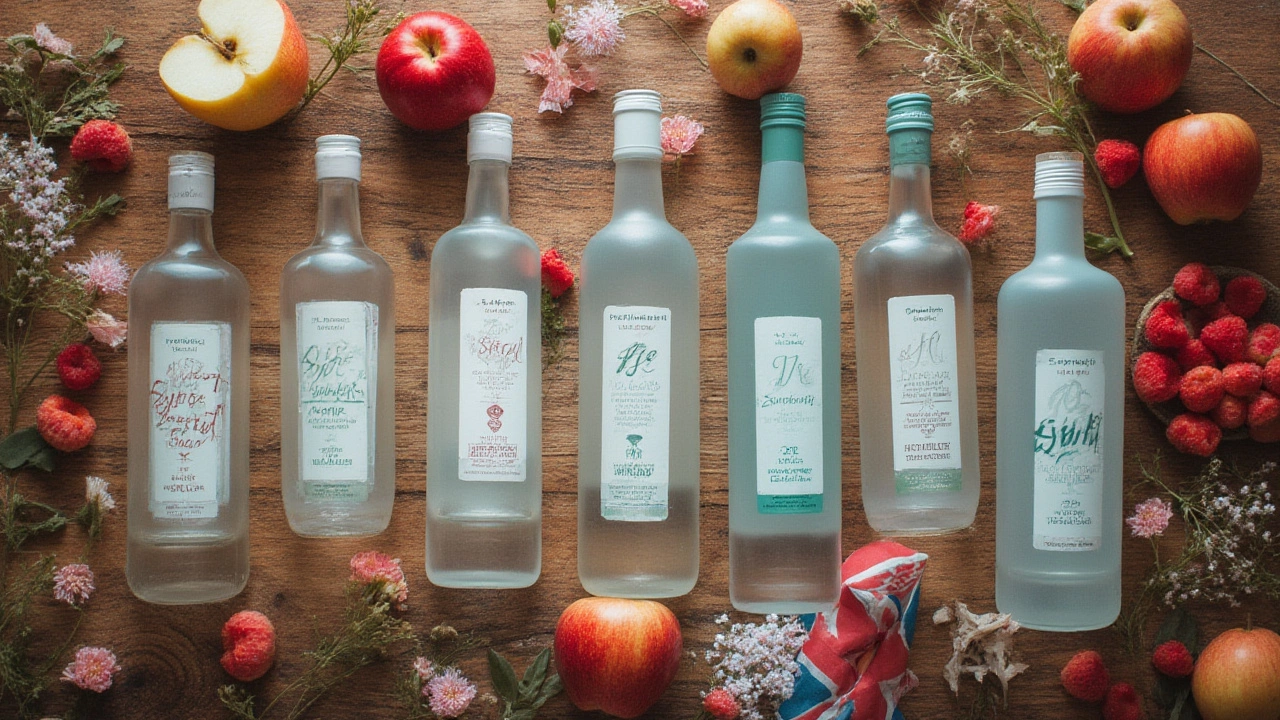You might not expect vodkas to have much difference between them—after all, isn’t it just odorless, colorless, and all about getting the job done? But here’s the twist: not all vodkas are created equal, especially if you care about what goes into your body. You head out for drinks or mix something at home, and there it is: rows of frosted bottles, all promising smoothness and purity. If you’re health-conscious—maybe counting calories, doggedly avoiding gluten, or dodging cheap additives—what should you actually reach for? Even Max, my dog, acts like he can sniff out the difference, but what does science say? Let’s get into how ‘healthy’ can mean more than one thing when we’re talking about vodka.
What Makes One Vodka Healthier Than Another?
The concept of the ‘healthiest vodka’ sounds almost like a joke if you imagine a rowdy college party, but there’s real science behind what goes into the bottle. First off, vodka is one of the lowest-calorie spirits you can pour. One shot (about 1.5 oz, or 44 ml) of 40% ABV vodka will hand you around 97 calories with zero sugar, carbs, or fat. Compare that to the syrupy calories in liqueurs or pre-mixed cocktails, and vodka already pulls ahead for calorie counters and keto fans.
But those calories are only part of the story. The real secret sauce comes down to what’s not in your vodka—impurities, allergens, additives, and so on. The purest vodkas are typically made with water and ethanol, distilled several times to remove fusel oils, methanol, and other byproducts that can rough you up the next morning. Look for terms like "multiple distillation" or "filtered"—some high-end vodkas brag about charcoal, diamond, or platinum filtration. While marketing hype runs wild in vodka branding, there’s a real reason distillers go through painstaking filtering: fewer congeners (those headache-causing compounds) mean a smoother, cleaner drink and sometimes a less brutal hangover.
Ingredients matter, too. The mash bill, which is the stuff vodka’s made from, can be grains like wheat, rye, or barley, but also potatoes, grapes, or even corn. Not only can this change the vodka’s flavor, but it also matters to anyone with gluten sensitivities. If you need to avoid gluten entirely, go for potato-based, corn-based, or grape-based vodkas. Fun fact: all distilled spirits are technically gluten-free due to the distillation process, but for extreme sensitivities or celiac, sticking to non-grain varieties adds peace of mind.
Now, additives. The healthiest vodkas contain nothing but water and alcohol. Some mass-market vodkas cut corners with glycerin, sugars, or artificial flavors to mask harshness or boost profit. Not exactly what you want when you’re trying to treat your body like a temple—even if just for the weekend. If you’re aiming for clean drinking, opt for bottles that list their ingredients openly and avoid anything with colors, sweeteners, or mystery flavor enhancers.
If you want to go one step further (and sound like a vodka snob at your next get-together), check for non-GMO certifications or organic labels. A couple of premium brands are transparent about sourcing and don’t use pesticides or genetically modified crops. Belvedere and Chopin wave the Polish flag for single-ingredient, no-additive vodkas. Tito’s Handmade is popular in the US for being gluten-free, made from corn, and for its straightforward ingredient list. If you care about eco-footprints and clean drinking, these brands give you something to toast to beyond the buzz.
So, here’s a table to break down what to look for, whether you’re scanning bar menus or squinting at bottle labels in-store:
| Factor | Why It Matters | Healthier Choice |
|---|---|---|
| Calories per shot | Helps you manage intake | Standard vodka, 97 kcal/1.5oz |
| Filtration method | Removes impurities & congeners | Multiple/distilled or charcoal-filtered |
| Ingredients | Avoids allergens and chemicals | Just water & alcohol; non-grain if gluten sensitive |
| Additives | Fewer junk ingredients, less risk of reaction | No added sugars/flavors |
| Certifications | Less pesticide/GMO | Organic, non-GMO |
The healthiest vodka isn’t about fancy packaging; it’s about purity, simple ingredients, and knowing what matters to you—whether it’s calories, allergens, or staying clean with every pour.

Brands That Get Vodka Health Right
I’ve gone through my fair share of vodka brands (never with Max—dogs and vodka don’t mix) and there are a few that health nuts seem to gravitate toward for solid reasons. You’ve got the staples that pop up on health blogs year after year: Tito’s Handmade, Chopin, Belvedere, and Ketel One.
Tito’s keeps things nutty simple. Made in Austin, Texas, from corn and nothing else but water and ethanol, it’s naturally gluten-free. They don’t mess with flavors or sugar, and it’s distilled six times for purity. The brand’s whole ‘handmade’ image isn’t just marketing—smaller batches make it easier to control what actually goes in, and that level of control pays off for drinkers who want to avoid junk. It’s also consistently $20–$30 a bottle, so you don’t have to break the bank to drink cleaner.
Chopin is the go-to for potato vodka fans—and here’s a fun stat: potato vodka often tastes creamier, and some folks claim it’s even easier on your system. Chopin uses Polish, non-GMO potatoes, no additives, and it’s still family-owned. Not spooky mass production here. If grain gives you a headache or you’re gluten-sensitive, this is where you want to look. Belvedere, also Polish and made from Dankowskie rye, takes things further with ‘no sugar added’ labels, no artificial flavors, and sustainability programs. They’re certified kosher, too, making them a frequent pick among various dietary-restricted drinkers.
Koskenkorva, from Finland, does something unusual—they use local barley, filtered spring water, and renewable bioenergy to run their distillery. If you’re not just health-minded, but also eco-obsessed, you’ll like their vibe. Ketel One (from the Netherlands) gets a lot of love among bartenders for its ‘crisp and clean’ vibe, no added sugar, and being distilled in copper pot stills. Their focus on sustainability in their Dutch distillery is worth a nod, too.
Lesser-known but strong contenders for the healthiest vodka corner include Snow Leopard (made from spelt for gluten-worriers), and Reyka (from Iceland—pure arctic spring water and geothermal-powered distilling). Prairie Organic comes out of the Midwest and is certified organic, using corn straight from Minnesota fields. Fewer chemicals and careful farming often mean a softer experience for your liver.
When it comes to health, the ‘budget’ shelf is trickier. Cheaper vodkas sometimes use more additives or slap ‘triple filtered’ on bottles that still burn on the way down. If you can, avoid flavored vodkas unless you know for sure there’s no added sugar—most raspberry or whipped cream vodkas come packed with sweeteners, so even if the buzz is the same, your waistline and morning-after self will know the truth.
If you want to geek out and make an informed choice on your own, here’s a run-down checklist:
- Check for ‘no additives’ or an ingredient list with just water and alcohol.
- Look for base ingredients—potato, corn, or grapes if you need to ditch gluten.
- Opt for organic or non-GMO if that matters for your diet or ethics.
- If calories are your biggest worry, open up brand websites for nutrition data—some are impressively transparent.
- Find out about the filtration process: charcoal or multi-step methods usually means fewer impurities.
A sliver of scientific research backs up that people who choose cleaner vodkas, drink them straight (or with soda water and lime), and avoid extra sugar, report fewer hangover symptoms. No vodka is truly ‘healthy’ in the green juice sense, but the way it’s made, the ingredients, and what’s left out can make your next night—or morning—a lot brighter.

How to Enjoy Vodka Without Derailing Your Health
We’ve all been there: counting calories, reading labels, maybe even scanning the back of the vodka bottle while friends are pouring shots. Drinking smarter isn’t just swapping soda for water—it’s about making each moment count without undoing your hard health work.
If you want to keep cocktails in your life but cut the regrets, try a few real-world tips. Start with straight vodka over fancy pre-mixed drinks. Most sugary, neon cocktails can easily pack more than 250–300 calories per glass, while a vodka soda with fresh citrus stays under 100. I always go for soda water with real lime, which crushes the craving for flavor but doesn’t pump in sugar or artificial sweeteners.
Chill your vodka—not just for taste, but the cold slows you down, gives you time to savor, and somehow makes each sip feel more special. And never underestimate the ritual of a decent glass: tall, lots of ice, maybe a sprig of mint if you need to feel like you’re at a ritzy bar. Presentation makes the experience feel like a treat, not a guilty secret.
Spacing your drinks with a glass of water (yeah, the classic drink-water-chaser move) really does make a difference. You’ll drink less, hydrate more, and your body will thank you. Research backs it up—people who alternate water with alcohol have fewer next-day headaches and lower risk of dehydration, which means fewer crazy hangovers and better skin. Max, my dog, goes wild if I neglect his water bowl, so take it from him: hydration matters, even if you’re not a Labrador.
Another trick? Mind the mixers. Tonic water sounds ‘light’ but usually packs 30–35 calories per 100 ml, plus added sugar or corn syrup. Opt for soda water, club soda, or even coconut water for a little flavor without the sugar spike. Want to get fancy? Toss in cucumber slices, muddled berries, or a dash of bitters (the kind with real botanicals, not syrupy liqueur). All the flavor, without the sugar sinkhole hiding in most cocktail mixers.
If you’re the kind who counts every crumb, measure your pour. A ‘free pour’ shot at home can quickly double your calories by accident. I use a jigger—not because I want to be a mixologist, but because I want a repeatable, guilt-free drink every time.
Let’s talk drinking frequency. Even the healthiest vodka can’t work miracles if you’re pouring it daily. The CDC and NHS both say adults should limit alcohol intake to moderate levels—up to one drink a day for women, two for men. That keeps things reasonable and won’t derail your health goals.
Last tip: know yourself, trust your body. If vodka leaves you feeling off—even the ‘cleanest’ kind—there’s no shame in skipping it or trying something else. If you really want to upgrade your routine, some folks swap a vodka tonic for an alcohol-free spirit or kombucha. Better sleep, better skin, no hangover, and no regrets in the morning (except maybe the memories of bad karaoke, but that’s on you).
So, the next time you line up shots or stir up a drink, remember: the healthiest vodka is the one that fits your needs—plain, pure, transparent, and with nothing extra. Your body—and your adventures—deserve nothing less.


